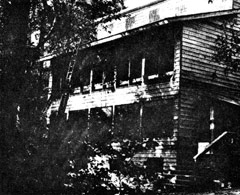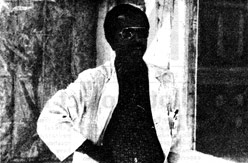|
Biochemist develops solar community
Duke Univ. Medical Ctr. Intercom, by Beth Parsons | Oct. 24, 1980
 Neurochemistry and solar energy share little common ground, but Dr. Freeman Ledbetter stands on what there is. Neurochemistry and solar energy share little common ground, but Dr. Freeman Ledbetter stands on what there is.
Ledbetter is a biochemist and research associate for Dr. Norman Kirshner, chairman of the Department of Pharmacology. Outside of the laboratory, however, he’s the developer of the first passive solar energy community in Durham and the southeast.
His interest in passive solar energy grew from concern about what he terms sub-standard housing construction which, he said, has led to higher fuel bills for everyone.
“I was dissatisfied with the construction in Durham and the energy loss in the typical conventional home,” he said.
His solution was to buy a 31-acre tract in the Hope Valley area which he named Green Mill after the Henry Green family, which operated a sawmill there until 1973.
Although Ledbetter owns the property. Green Mill is a family venture with his brother helping to promote the development.
When planning the solar residential community, Ledbetter had a choice between active solar energy systems and passive solar energy design. He chose passive because of cost comparisons and practicality.
“An active solar energy house requires expensive solar collectors, fluid pumps and storage bins,” he said. “In this climate, active solar energy systems aren’t worth their cost for the percentage of the year we heat our homes.”
Passive energy design includes strategic positioning of the house on the land, and placement of windows and greenhouses for maximum heat collection. Ledbetter divided Green Mill into 36 lots, each surveyed for a southerly house. Buyers are guaranteed access to solar energy without obstruction from trees or other houses.
Ledbetter said solar design offers several advantages for future home builders.
 Energy, loan costs Energy, loan costs
“The major hurts in the housing industry are the cost of energy and the cost of loans,” he said. “The combination is forcing people to move into smaller houses. If we can help alleviate the cost of energy we’re addressing the problem “If people build solar homes and cut their energy bills in half, they have more money for mortgage payments. They may also be able to afford a larger home,” he said. “In the next five years, maybe earlier, construction is going to swing to passive solar, it’s going to have to.”
Prices and styles of solar homes range widely. Ledbetter has specifications for three passive designs, but buyers in Green Mill are not obligated to choose one. In some cases, he said, a passive solar home can cost less to build than a conventional home.
Tax credit
Tax credit is another attraction to building a solar home. An active solar energy hot water heater costs approximately $2,400. North Carolina offers a 25 percent tax credit on solar equipment and the federal government allows up to 40 percent. A 65 percent tax credit reduces its original cost to about $800.
Ledbetter said that being a biochemist makes him more aware of the environmental advantages of a passive solar home.
|